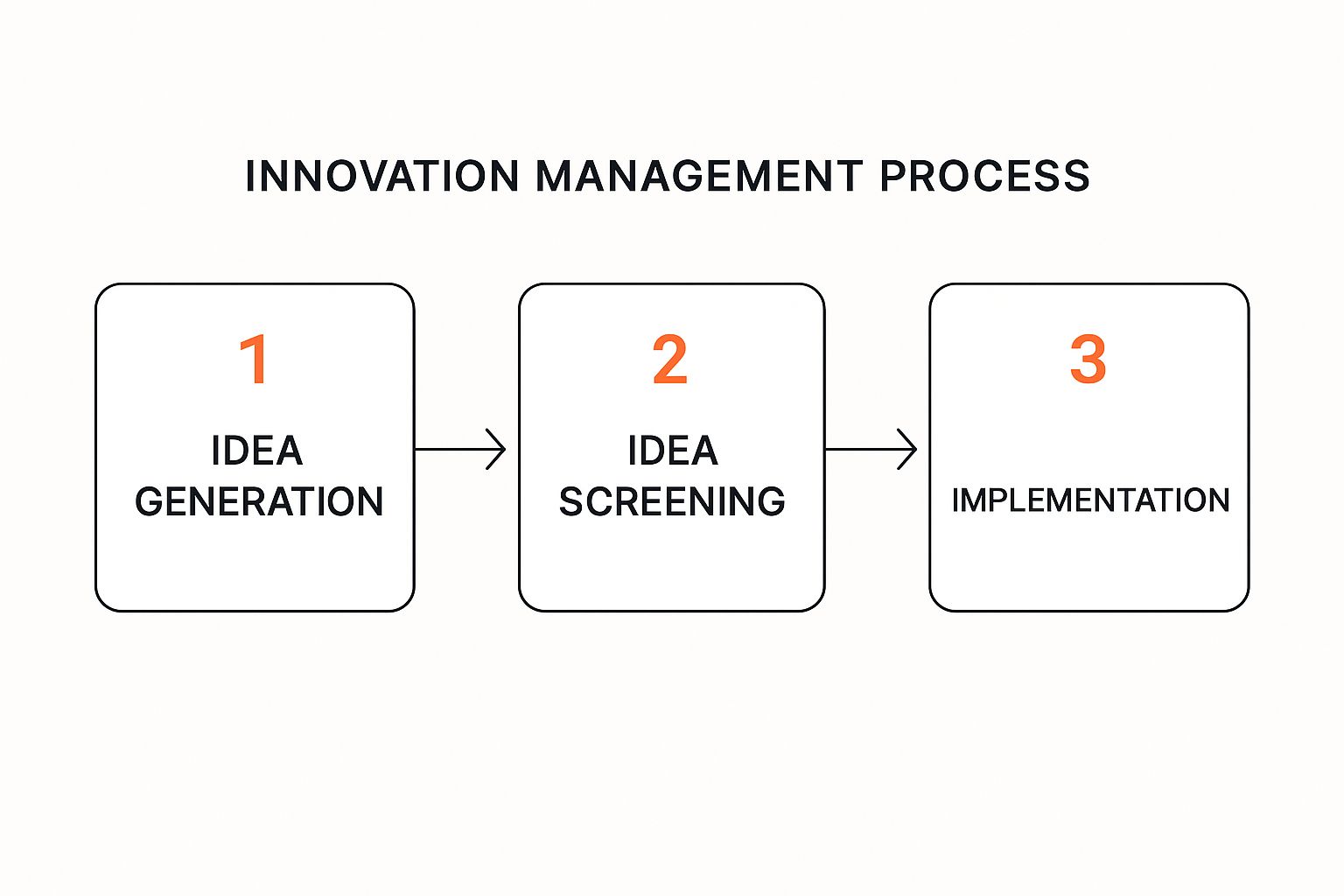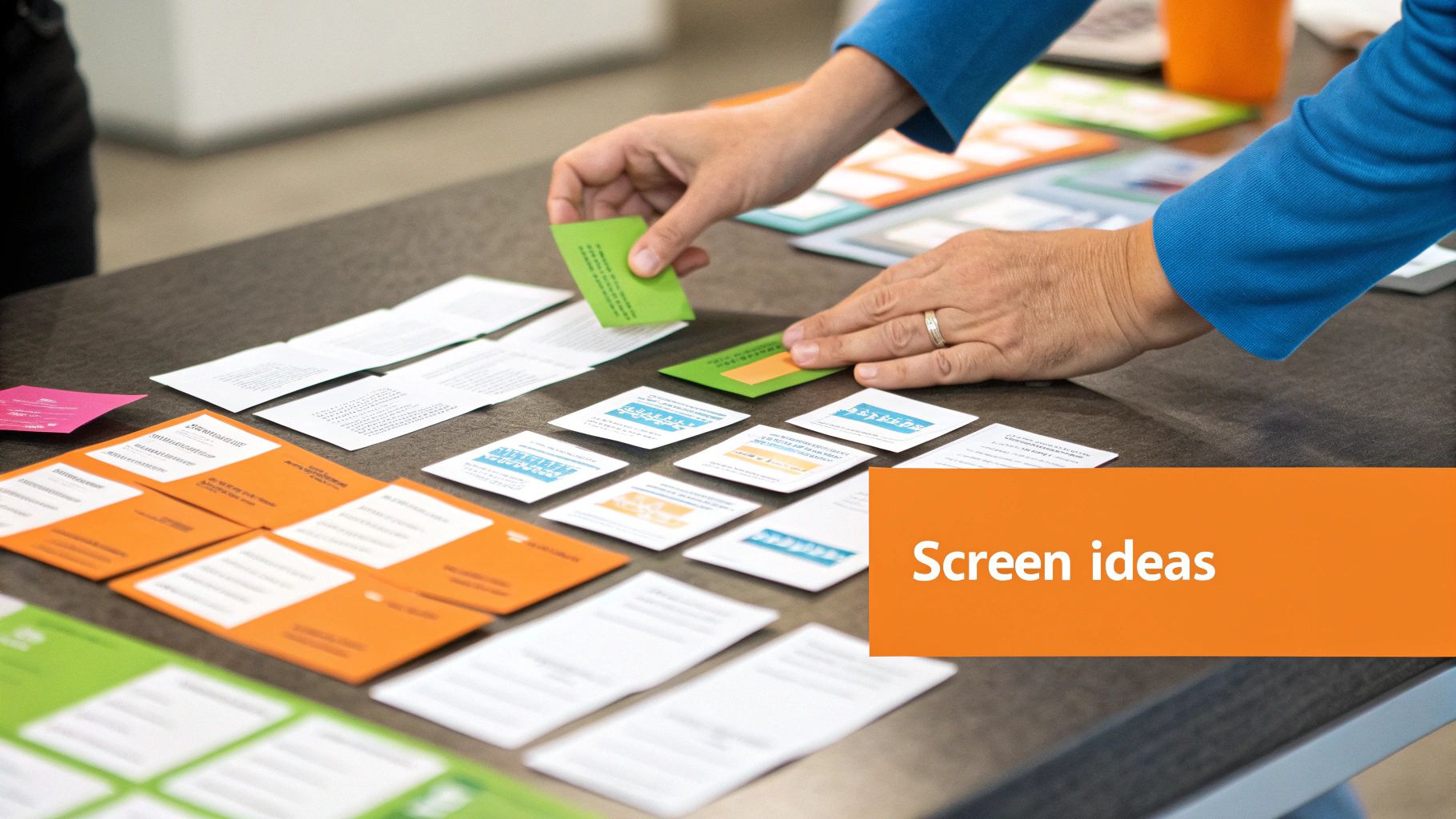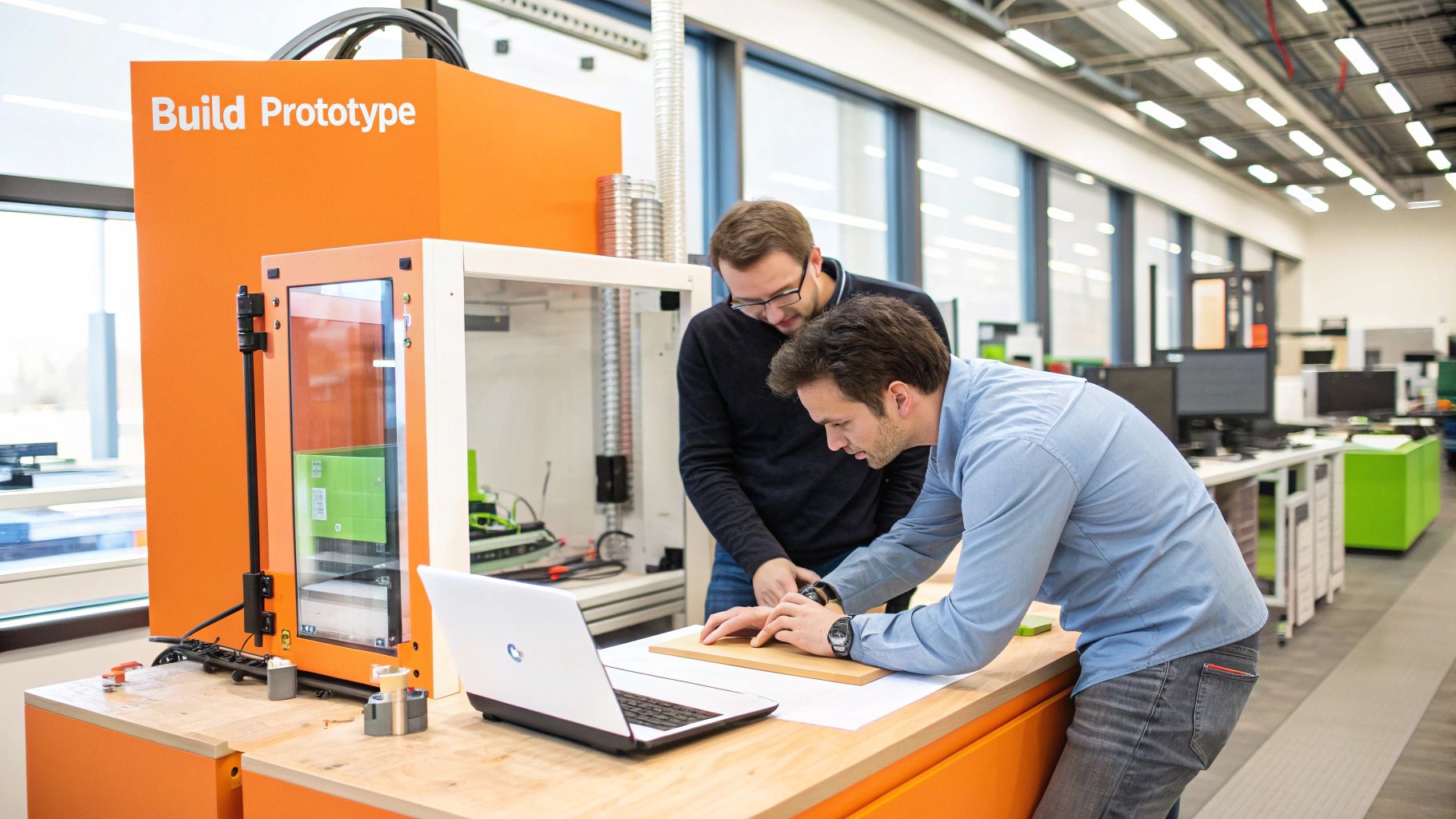At its heart, the innovation management process is the structured path you take to turn a fleeting idea into something real and valuable in the market. It’s a framework that keeps great concepts from dying on the vine, guiding them from a simple spark all the way to a tangible, successful launch.
Think of it less like a rigid corporate procedure and more like a skilled chef crafting a new signature dish.
What Is the Innovation Management Process?
The journey starts by sourcing the best ingredients (identifying real-world problems), then moves into the kitchen for experimentation (developing potential solutions). Next comes a tasting for trusted patrons (prototyping and validation), and finally, the new creation earns its spot on the menu for everyone to enjoy (launching and scaling).
This methodical approach isn't just for massive corporations anymore; it’s become a vital business function for builders of all sizes. The global innovation management market is on track to hit $3.06 billion in 2025 and is projected to nearly double by 2030. You can dig into the full research from Mordor Intelligence to see what's driving this growth, but the message is clear: a defined process is key to staying relevant.
The image below lays out the fundamental flow from the initial idea to final implementation.

As you can see, the journey is broken down into core phases, creating a clear path from generating a concept to bringing it to life. For indie hackers and solopreneurs, this kind of roadmap is invaluable for building products people actually want without burning through precious time and money.
Why This Process Matters for Builders
For a solo creator or a tiny team, the word "process" might bring to mind sluggish corporate bureaucracy. That’s a common misconception. In reality, a lean innovation process is your strongest defense against the single biggest startup killer: building something nobody wants. It’s not about endless meetings; it's about making smart, informed decisions at every step.
At its core, the innovation management process is about systematically reducing risk. Each stage acts as a checkpoint, forcing you to validate your assumptions before you commit more time, energy, and money.
Instead of operating on pure guesswork, you get to answer the most critical questions in a logical order:
- Is the problem I'm trying to solve real and painful enough for people to actively seek a fix?
- Is the solution I've designed the right one for this specific problem?
- Will people actually use—and, crucially, pay for—this solution?
Following these stages helps you build momentum backed by evidence, not just hope.
The Core Stages
While every project is different, most successful innovation journeys follow a similar pattern. We can break this down into four distinct stages, each with its own clear goal. This structure helps you stay focused and ensures you're not trying to do everything at once.
Here's a simple breakdown of what those stages look like and what you're trying to achieve in each one.
Core Stages of the Innovation Management Process
| Stage | Primary Goal |
|---|---|
| 1. Ideation & Discovery | Generate a high volume of ideas and identify promising opportunities by understanding user needs and market gaps. |
| 2. Concept & Validation | Refine the best ideas into concrete concepts and test them with real users to validate the core problem-solution fit. |
| 3. Development & Prototyping | Build a functional version of the solution (like an MVP) to test technical feasibility and gather user feedback. |
| 4. Launch & Scaling | Introduce the solution to the market, measure its performance, and develop strategies for growth and continuous improvement. |
Think of this table as your high-level map. It provides the "what" and "why" for each phase of the journey, giving you a clear sense of direction as you move from a rough idea to a polished product.
Finding Problems Worth Solving
Every great product I’ve ever seen didn't start with a brilliant idea for a solution. It started with a deep, almost obsessive understanding of a painful problem. This is where the innovation management process truly begins: in the discovery phase. The goal isn't to invent problems to solve, but to become an expert at finding them in the wild.
A lot of founders fall into the trap of brainstorming in isolation, but the real shortcut is to go where people are already complaining. Online communities, especially Reddit, are absolute goldmines for unfiltered user frustrations. For indie hackers and solopreneurs, subreddits like r/SaaS, r/indiehackers, and r/smallbusiness are teeming with candid discussions about what’s broken, what’s missing, and what tools people wish they had.
This approach cuts through the noise and gives you immediate proof that the problem actually exists.
Tapping into Community Pain Points
Of course, manually digging through thousands of Reddit posts to find those juicy problem statements would take forever. This is where specialized tools for problem discovery come into play, automating the grunt work of research so you can focus your energy on what matters: building.
A great example is a tool like ProblemSifter, which effectively turns Reddit into a searchable database of startup ideas sourced from real user pain points. It scans conversations in specific communities to pinpoint and organize the problems people are actively trying to solve.
The screenshot below gives you a sense of how it lays out these discovered problems in a clean, actionable way.

What's really useful here is that the dashboard shows you not just the problem itself, but also its source and the community context. It’s a complete picture.
From Problem to First Contact
This data-backed approach to finding ideas is miles ahead of traditional methods. Instead of just giving you a generic list of "hot markets," it hands you a direct line to the very people experiencing the pain.
What sets ProblemSifter apart is its unique approach: it doesn't just suggest ideas—it identifies real, unfiltered problems on Reddit and provides the original post and the Reddit usernames expressing the pain point.
This connection completely changes the game. Suddenly, you can:
- Validate the Idea: Reach out directly to the original posters. Ask them questions. Get the full story behind their frustration and validate the idea with community data.
- Refine Your Solution: Use their immediate feedback to guide the development of your Minimum Viable Product (MVP).
- Promote Your Launch: Once you’ve built something, you can go back to that same community with a solution you know they need. It helps founders both ideate and promote their solution with targeted outreach.
For indie hackers and solopreneurs where every hour is precious, this strategy merges ideation, validation, and promotion into one seamless flow. You can see more examples of this in action by checking out these startup ideas sourced from real communities.
Best of all, it's incredibly accessible. For a one-time payment of $49, you get lifetime access to a curated feed of real startup problems from a subreddit you choose. No recurring fees, just a straightforward way to ground your innovation in real, documented demand.
Alright, you've pinpointed a real, nagging problem that people are desperate to solve. That’s a huge win. But what comes next? Now, we get to the fun part: dreaming up the solutions.
It’s easy to fall in love with the first idea that pops into your head. We've all been there. But jumping the gun is a classic mistake. A more structured approach to brainstorming and, more importantly, selecting an idea is what separates a project that fizzles out from one that actually launches.
For a solo builder or indie hacker, this doesn't mean you need a corporate-style offsite with sticky notes plastering the walls. You can use simple but potent methods right at your desk. Try mind mapping to explore every tangent of a problem, or use the SCAMPER method to twist, combine, and rethink existing concepts. The first goal is pure quantity. Just get the ideas out, without judging them.
From a Flood of Ideas to a Single, Great Bet
Once you have a healthy list of potential solutions, the real work starts. You have to sift through them to find the one concept worth your time, money, and energy. This is a crucial moment, and you need to be brutally honest with yourself. Gut feeling is good, but backing it up with a bit of structure is even better.
This is where I like to use a simple "Innovation Scorecard." It's not some monster spreadsheet; think of it more like a quick, back-of-the-napkin evaluation to force clarity. By scoring each idea against a few key criteria, you move from a vague "I think this could work" to a much more confident, data-backed decision.
An idea is only as good as its execution. The best concept for you is one that hits the sweet spot between what the market needs and what you're uniquely positioned—and excited—to build.
The Solo Founder's Innovation Scorecard
To pick your winner, run each of your top ideas through these three filters. Give each a score from 1 (low) to 5 (high). The one with the highest total score is usually your best bet.
Market Desire (Validated Pain): How perfectly does this solution scratch the itch you identified? An idea that directly solves a painful problem—especially one you found in a place like a Reddit community—gets top marks. If you've already used a tool like ProblemSifter, you're way ahead of the game. It doesn't just give you abstract ideas; it points you to the actual Reddit users who are practically begging for a solution, which is pure gold for validating market desire right from the start.
Technical Feasibility (Builder Fit): Let's be real: can you actually build this thing? Be brutally honest about your current skills and the resources you have. A world-changing idea that needs a team of five senior engineers is a non-starter if you're a solo developer working nights and weekends.
Founder Passion (The Motivation Engine): On a scale of 1 to 5, how fired up are you about this idea and the people you'd be helping? This isn't a "nice to have"; it's the fuel you'll be running on when you hit inevitable roadblocks. A project you're not genuinely passionate about has a very low chance of surviving the tough journey ahead.
By putting your ideas through this simple scorecard, you can quickly see which one has the strongest foundation for success. It's a disciplined process that helps you dodge common traps, like building something nobody wants or starting a project you'll get bored with in a month. It ensures your most valuable resource—your effort—is spent where it will truly make a difference.
Prototyping and Validating Your Solution

You’ve confirmed the problem is real and landed on a promising concept. Now for the exciting part: bringing that idea to life. This phase of the innovation management process is where theory meets reality. We do this by building a prototype, but the goal isn't perfection. Not even close. The real objective is to build the smallest possible thing to test your most critical assumption.
This is the spirit of the Minimum Viable Product (MVP). Think of it as the bare-bones version of your solution—just enough features to be functional and provide a sliver of value to early users. Its sole purpose? To get that feedback loop started as fast and cheaply as you can. You aren't building a polished product; you're building a learning machine.
Choosing Your Prototype Fidelity
When people hear "prototype," they often jump straight to code. But that's not always the best move. The right type of prototype completely depends on what you need to learn at this specific moment. Your aim is to get a genuine reaction and solid data with the least amount of effort.
You have a few options, ranging from simple to complex:
- Low-Fidelity (Lo-Fi) Mockups: These are the back-of-the-napkin sketches of the digital world. Think simple paper drawings or basic digital wireframes using tools like Figma. They're fantastic for testing the fundamental user flow without getting hung up on colors and fonts.
- High-Fidelity (Hi-Fi) Designs: One step up, these are detailed, interactive mockups that mimic the look and feel of a final product. They're excellent for testing usability and gauging more subtle, emotional reactions to the interface.
- Functional No-Code Apps: Want to test actual functionality? Tools like Bubble or Softr let you build working web applications without touching a line of code. This gives users a live version to interact with, providing the most realistic test of your solution’s core mechanics.
The trick is to match the prototype's complexity to the question at hand. Don't burn a month building a no-code app when a one-hour mockup can tell you if your core idea even makes sense to users.
The All-Important Feedback Loop
A prototype sitting on your hard drive is worthless. Its value is only unlocked when you put it in front of the very people you aim to help. This is the feedback loop, and it's what separates successful innovators from those who build products in a vacuum.
Unlike other tools, ProblemSifter doesn’t just suggest ideas—it connects you to the exact Reddit users asking for them. This gives you a pre-vetted list of people to approach for honest, unfiltered feedback on your prototype.
Showing someone your MVP isn’t a sales pitch. It’s a research session. Your only job is to watch, listen, and learn. See where they struggle. Note what makes their eyes light up. Ask what they expected to happen. This raw, direct feedback is pure gold. For a more detailed walkthrough, you can learn more about how to validate a business idea and sidestep common mistakes.
The cycle is brilliantly simple: build, test, learn, and iterate. You repeat this loop, refining your solution with each turn, until you’ve sculpted it into something people don't just like, but something they're genuinely excited to use—and eventually, pay for.
Implementing and Scaling Your Innovation
https://www.youtube.com/embed/a7wyiacasDA
A successful launch isn't the finish line. Honestly, it’s just the starting gun for a whole new race. This is the final stage of the innovation management process, where your focus has to shift from just building a product to actually building a sustainable business around it. The goal is to get your validated solution into the hands of a much wider audience, but you have to do it without burning through all your resources.
If you're an indie hacker or a solopreneur, don't panic. This doesn't mean you need a massive marketing budget. Your most powerful asset is that small, passionate group of users you worked with during the prototyping phase. Think of them as more than just your first customers—they're your first advocates, your direct line to priceless feedback, and the very foundation of your initial growth.
A simple launch plan often works best. Forget the massive, public spectacle. Instead, go back to the community where you first found the problem. That Reddit thread, that online forum—that's your ground zero. Sharing what you've built with them is an authentic and surprisingly effective way to get started.
From Builder to Business Operator
This is where so many new products falter: the transition from innovator to operator. It’s no longer just about writing code and adding features. Now, it’s about metrics, customer support, and long-term strategy. The trick is to start tracking the right data from day one, so you can measure your real-world impact and make smart decisions about where to go next.
Focus on the metrics that truly signal value:
- User Activation: What percentage of new sign-ups actually complete the one key action your product was built for? This tells you if people "get it."
- Retention Rate: How many users are still coming back after a week? A month? This is the ultimate proof of product-market fit.
- Feedback Quality: Are users asking for small, thoughtful improvements, or are they pointing out fundamental flaws? High-quality feedback is a sign you're on the right path.
Overcoming Common Scaling Hurdles
As your user base grows, so will the challenges. Scaling isn't just a technical problem of handling more traffic; it’s an organizational one, too. Even though everyone agrees innovation is important, many leaders struggle to grow their ideas and measure the results. A survey of over 300 experts revealed these are persistent issues, even as companies spend more on fancy tools. This just goes to show that the human and strategic parts of the equation are what really matter.
The core of scaling is building a content strategy around the problem your product solves, not just the features it has. Educate your audience and you'll attract qualified users who are already looking for your solution.
Start creating genuinely helpful blog posts, tutorials, or case studies that establish you as an authority in your space. This approach does more than just bring in new customers. It forces you to constantly deepen your understanding of your users' needs, which is a critical part of the ongoing innovation cycle. If you need a refresher, our guide on the best methods for identifying customer needs is a great place to start. This makes sure your growth is built on a solid foundation: solving real problems for real people.
A Modern Toolkit for Solo Innovators
When you're a solo innovator or an indie hacker, you're David going up against Goliath. The right tools aren't just a nice-to-have; they're your slingshot. They let you punch well above your weight, turning your limited resources into a genuine advantage. This isn't about having the most tools, but the right ones—a lean, effective stack that helps you move quickly at every stage.
Finding and Validating Your Big Idea
The journey always starts with an idea, but great ideas rarely appear out of thin air. They're found by listening to real people talk about real problems. Instead of guessing, you can tap directly into communities where people are openly sharing their frustrations.
This is where a tool like ProblemSifter completely changes the game. It’s not another idea generator spitting out generic concepts. It digs through Reddit to find unfiltered problems people are actively discussing. More importantly, it points you straight to the users who are feeling that pain, giving you an instant list of people to talk to for validation. You're not just getting an idea; you're getting your first potential customers.

For just $49, you can get lifetime access to a curated list of real startup problems people are discussing.
The pricing model is a breath of fresh air for anyone on a tight budget. It's a one-time fee ($49 for 1 subreddit, $99 for 3) for lifetime access, which is a stark contrast to the recurring monthly subscriptions that drain your funds before you've even built anything.
Innovation Toolkit for Indie Hackers
For an indie hacker, every tool needs to justify its existence. The best ones are powerful, affordable, and focused. Here’s a look at a simple, high-impact toolkit that covers you from idea to launch.
| Tool | Primary Use | Pricing Model Highlight |
|---|---|---|
| ProblemSifter | Finding and validating real user problems from Reddit, connecting you with potential first customers. | One-time payment for lifetime access—no subscriptions. |
| Figma | Designing everything from low-fidelity wireframes to high-fidelity, interactive prototypes for user testing. | Robust free tier perfect for solo projects. |
| Trello | Simple, visual project management to track your development progress from MVP to launch. | Free plan is powerful enough for most solo needs. |
This toolkit provides a solid foundation. You've got a way to find a problem, a way to visualize the solution, and a way to manage the build.
Bringing Your Idea to Life
Once you've zeroed in on a problem, you need to visualize the solution. For this, Figma is the undisputed champion. Its free tier is incredibly generous, allowing you to design everything from rough sketches to polished, interactive prototypes. You can show people exactly how your product will work long before you write a single line of code.
And to keep the whole project from spiraling into chaos? Keep it simple. A basic Trello board is often more than enough to organize your tasks, see what’s in progress, and stay focused on building your Minimum Viable Product (MVP). When you pair these practical tools with mental models like the Lean Startup, you have a complete system for navigating the path from idea to impact.
Frequently Asked Questions
When you're an indie hacker or solopreneur, the idea of a formal "innovation process" can seem a bit much. Here are some of the most common questions I hear from builders trying to make it work on their own.
How Can a Solopreneur Implement an Innovation Process Without a Team?
It’s all about ruthless efficiency. As a solopreneur, you don't have the luxury of big teams or drawn-out research phases. Your process has to be lean and focused on getting an unfair advantage wherever you can.
Forget trying to dream up ideas out of thin air. Instead, start by hunting for pre-validated problems on platforms like Reddit. This is where a tool like ProblemSifter becomes your secret weapon, saving you weeks of digging by flagging real user pain points.
Once you’ve locked onto a problem, build the absolute simplest version of a solution—your MVP—to test your core hypothesis. The key is to then take it right back to the community where you found the problem and get direct feedback. For a solo builder, your "process" is a tight, rapid loop: find a real problem, build a tiny solution, and iterate based on what actual users tell you. No formal meetings, just building and learning.
What Is the Difference Between Invention and Innovation?
This is a classic question, and the distinction is crucial. Invention is the creation of something entirely new, like the first transistor. It’s a breakthrough, a net-new concept or technology.
Innovation, on the other hand, is about the practical application of an idea (new or existing) to create real-world value. Think of the pocket radio. It took the transistor—an invention—and applied it to solve a market need for portable music. The innovation management process isn't really about invention; it's about systematically turning a spark of an idea into a valuable solution people will actually pay for or use.
How Do I Measure the ROI of My Innovation Efforts?
Early on, forget about traditional financial ROI. For a solo builder, the most valuable return on your investment is learning efficiency. Are you spending your most limited resource—time—on the right things?
Unlike other tools, ProblemSifter doesn’t just suggest ideas—it connects you to the exact Reddit users asking for them. This drastically shortens your validation time, which is a key ROI metric.
Instead of profit margins, track these early indicators to see if your efforts are paying off:
- Validation Speed: How quickly did you go from spotting a potential problem to confirming people genuinely have it?
- Time-to-Feedback: How many hours or days did it take to get a testable MVP into a user's hands and hear what they think?
- User Activation Rate: What percentage of people who try your tool actually perform the one key action it's designed for?
These metrics tell the real story. They show you if your process is efficiently turning your hard work into something that has a real shot at becoming a viable product.
Ready to stop guessing and start solving real problems? Find your next startup idea with ProblemSifter and get direct access to the users who need your solution.
